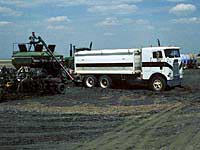|
|

|

|

|
|
Prairie grain farmers have improved production methods over the years. As part of sustainable agricultural methods, farmers operate farms in an environmentally responsible manner by using conservation methods and modern technology with the goal of maximizing yields and preserving the environment for future generations. They must make the most of a small amount of moisture, and take special precautions to protect the soil from the devastating effects of wind and water erosion.
|
|

The type of cropping practice a farmer chooses has a lot to do with the type of crop that is planned in a rotation. The different crops grown in Saskatchewan vary in the depth and rate of seeding, fertilization, weed control, harvesting
and storage methods and management of crops, from seeding to harvest, may influence the success of the crop.
|

For centuries, tillage has been used to grow crops. In early years, farmers used the mouldboard plough, which turned the soil over and buried grass or stubble left on the surface.
|
|
Often, stubble left from the previous crop was burned before the land was worked. The plough buried the plant matter too deep to protect the land from wind or runoff water; burning the stubble exposed the soil to erosion. As agriculture developed, the environment itself began to change. Crops and tillage replaced grasslands, trees, natural fires and animals that had shaped the province. As a result, the land changed and the soil changed. As mechanization increased, soil erosion became more evident. Over the years, the soil became fine and powdery, with little moisture or nutrients available for crops. In the 1930's, when several dry, windy years occurred in a row, the soil blew away. The fields dried up and crops produced no grain. Some traditional methods of crop production are still in use today.
|
|
|
Today, farmers are expected to produce food in ever increasing quantities. In order to produce quality crops, soil erosion must be dealt with and farmers practice soil conservation techniques.
The soil is tilled (broken up) to a lesser extent than in earlier days and more plant matter (referred to as trash) is left on the field. Leaving plant matter on the surface protects the soil from erosion and catches winter snow to add extra moisture to the soil in the spring.
|
|
|
Tillage is any kind of cultivation, disturbance or turning over of soil, designed to eventually produce plants or crops. Any cropping practice includes tillage operations. Tillage (cultivation) may be used
to speed up the breakdown and incorporation of previous
crop residue, kill weeds and volunteer plants or level and prepare
seedbeds.
|
|
|
Tilling gets rid of weeds and buries plant matter which rots and replenishes some of the lost soil nutrients. But on the dry prairies, the more the soil is tilled and loosened -- the more likely it is to blow away or wash away. To prevent erosion, farmers are using crop production techniques such as
- zero-tillage, where crops are seeded directly into stubble without tilling the soil first,
- minimum tillage, where there is only lightly tilling the soil and this is done fewer times a year,
- and less summerfallow where fields are tilled and left to lay idle or "fallow" for a season or more.
|
|
|
These methods also benefit farmers and the environment by reducing the amount of fuel needed to till the land. Without tilling to get rid of weeds and replenish soil nutrients, farmers using zero till and minimum till need to add chemical herbicides to keep weeds down and fertilizers to replenish soil nutrients.
In very windy areas, farmers often plant crops in strips across the prevailing wind to prevent the soil from blowing. Shelterbelts -- rows of trees planted as windbreaks -- also help prevent erosion and conserve moisture.
Modern prairie grain production consists of large-scale, mechanized operations, each requiring its own specialized equipment. Most farmers are in the land early in the spring, preparing the field for seeding by applying fertilizer and pre-emergent herbicides (weed control chemical incorporated in to the soil before seeding). Some of this work may begin in the fall.
|
|
|
|
|
